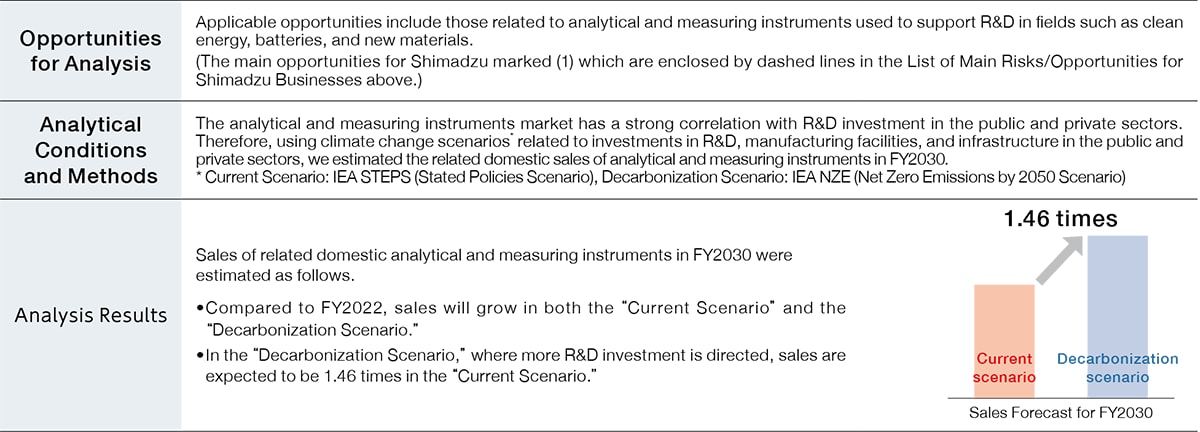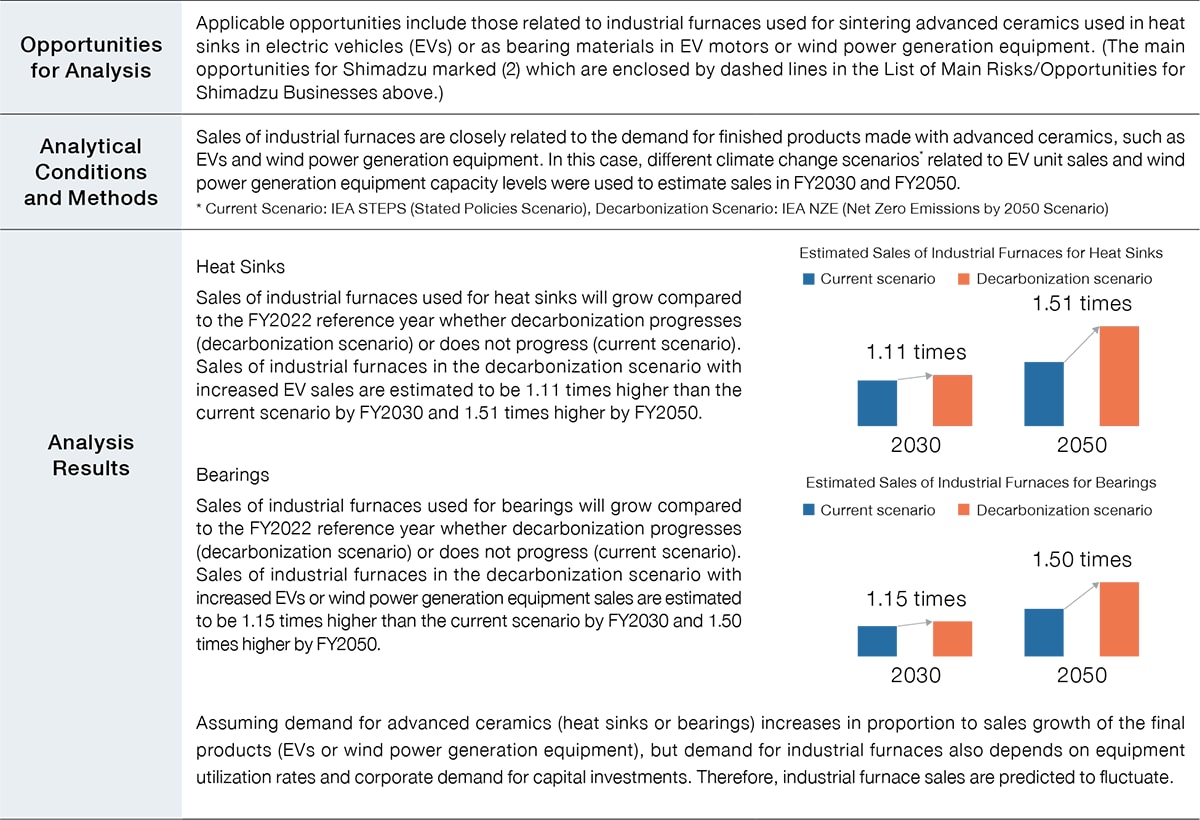TCFD Measures for Addressing Climate Change
The Shimadzu Group regards environmental problems as one of its most important management challenges. To address the problem of climate change in particular, we are working to reduce CO2 emissions generated from our business activities across the entire value chain and offer products and solutions that contribute to creating innovations in the so-called green (GX) environmental domain.We endorse the recommendations of the Task Force on Climate-related Financial Disclosures (TCFD) and remain committed to disclosing relevant information.

Governance
The Shimadzu Group discusses climate-related risks and opportunities, as well as measures to resolve managementrelated issues, at the“ Environmental Meeting” (chaired by the President and held twice a year), a subcommittee specializing in environmental issues.Discussions are reported to the Executive Committee, and are also reported to and discussed by the Board of Directors, thereby ensuring appropriate monitoring and supervision by the Board. The Board of Directors also deliberates and decides on important matters related to Shimadzu’s environmental management.

Risk Management
The Global Environmental Management Department is the main body that identifies individual climate change risks that could affect the Shimadzu Group’s business, strategy, and finances. In assessing the risks, Shimadzu identifies risks that are highly significant to the Group by assessing the degree and timing of the impact with reference to climate change scenarios issued by the IEA (International Energy Agency) and other organizations. The results of the identification and assessment are discussed and confirmed by the Environmental Meeting.
Strategy for Addressing Climate Change
1. Identify Climate-Change Risks and Opportunities
When identifying climate-related risks and opportunities that could affect Shimadzu Group businesses, strategies, or finances, we identify and organize climate change-induced drivers expected to have a large impact on Shimadzu businesses in each of two global scenarios, one where carbon reduction efforts result in a 1.5 °C temperature increase and the other where current global warming trends increase temperatures by 4 °C.

Starting with the climate change-induced drivers above, the main risks and opportunities related to climate change were identified and evaluated in terms of timeframe and impact level based on the International Energy Agency (IEA) climate change scenarios and other factors. The results are summarized in the“ Main Risks/Opportunities for Shimadzu Businesses” table below.
List of Main Risks/Opportunities for Shimadzu Businesses

① Scenario Analysis of Demand Growth for Analytical and Measuring Instruments
While it is expected that research and technological development related to carbon neutrality will continue to advance in various industrial fields, we have conducted a scenario analysis regarding opportunities in the measuring instrument business (expanded demand for analytical and measuring instruments) using multiple temperature range scenarios.

② Analysis of Scenarios for Expanding Demand for Industrial Machinery (Industrial Furnaces for Advanced Ceramics Field)
During the expected advancements in socioeconomic transitions to a carbon-free society, multiple temperature zone scenarios have been used for a scenario analysis of the industrial machinery business (advanced ceramics field).

2. Impact on Shimadzu’s Business, Strategy, and Finances under Climate Change Scenarios
Results from analyzing the impacts on Shimadzu businesses, strategies, an d finances for a carbon-free scenario (1.5°C hotter) and the current scenario (4°C hotter) are summarized below.


Impact on Shimadzu’s Business, Strategy, and Finances under Climate Change Scenarios
Shimadzu is working to reduce CO2 emissions in its business activities by actively promoting energy conservation and utilizing renewable energy, and the actual amount of CO2 emissions in FY2023 was 10,778 tons. We also provide products and services to a variety of industries, including pharmaceuticals, medical, environmental, energy, semiconductors, and materials, making us unique in that we serve a broad base of client industries. As a result, we believe it is very unlikely that a contraction in any particular industry would have a significant impact on Shimadzu finances.
Although opportunities f rom climate change are expected i n various industries and fields in both a “1.5°C hotter world” and a “4°C hotter world,” we recognize that efforts to realize a “1.5°C hotter world” will lead to a reduction in risks for society as a whole. Therefore, Shimadzu is working to achieve the 1.5°C target through its business activities. Specifically, Shimadzu designs all its products to be environmentally friendly, such as by making them more energy efficient, and continues to increase the percentage of Eco-Products Plus products that offer particularly high environmental performance.We also continue to invest i n the development and supply of products that contribute to climate change mitigation and adaptation. Overall, we believe that our business, strategy, and finances can remain resilient to climate change by appropriately seizing climate change opportunities and achieving sustainable growth through the actions and initiatives outlined in the transition plan on the following page.
3. Transition Plan for Achieving a Carbon-Free Society
- Mitigation of Climate Change (Achieve 1.5 °C Target)
To achieve the 1.5 °C target specified by the Paris Agreement, the Shimadzu Group has set a target of net-zero CO2 emissions from business activities by 2050 and is actively working to reduce CO2 emissions accordingly. In addition, to reduce CO2 emissions in our supply chain, we have set a reduction target regarding CO2 emissions from the use of Shimadzu product at customer sites.Targets, performance, and progress for these measures are monitored and overseen under the Climate Change Governance system and reviewed and updated on a regular basis. - Capitalize on and Maximize Opportunities
We will strategically develop and supply products that contribute to climate change mitigation and adaptation, and support our customers’ efforts to decarbonize their businesses, in our efforts to achieve sustainable growth. In addition, Shimadzu will continue to strengthen its development infrastructure and supply system in response to the changing demands for its products. Shimadzu policies, plans, and other information for each of the main business fields are indicated in Shimadzu Group’s Policies and Plans for Initiatives in Each of its Business Fields to Build a Carbon-free Society below.
Shimadzu Group’s Policies and Plans for Initiatives in Each of its Business Fields to Build a Carbon-free Society

Indicators and Targets
1. Reducing CO2 Emissions
The Shimadzu Group intends to reduce CO2 emissions from business activities to net-zero (carbon neutral) by 2050.
FY 2050 Targets
- Reduce CO2 emissions from business activities to net-zero.
- Increase the percentage of renewable energy use to 100 %.
FY 2040 Target
- Reduce CO2 emissions from business activities by at least 90 % compared to FY 2017.
FY 2030 Target
- Reduce CO2 emissions from business activities by at least 85 % compared to FY 2017*
- Reduce CO2 emissions from the use of products sold by the Shimadzu Group by at least 30 % compared to FY 2020 levels.
- * Obtained SBT“ 1.5°C level” certification for this goal
2. Development and Promotion of Certified Environmentally Friendly Products
The Shimadzu Group is committed to improving the environmental friendliness of products and minimizing our impact on the global environment. Products with superior environmental performance than previous models are indicated in brochures and other literature as certified “Eco-Products Plus” products. In addition, ECO Simulation Software is available via the Shimadzu website that can be used to compare the running costs of new products versus previous models. That allows customers to visualize running costs and their contribution to reducing CO2 emissions if their current model is replaced with a new model. Promoting sales of products with superior environmental performance is viewed as an opportunity for the Shimadzu Group. We will promote carbon neutrality by offering products that help customers reduce CO2 emissions.








